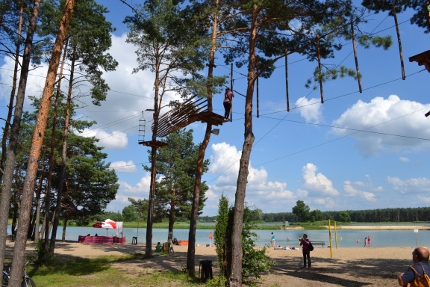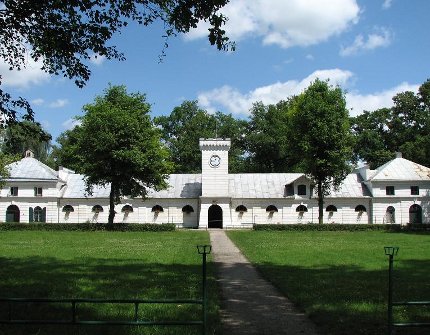Places

One of the most important Orthodox sanctuaries in Poland, with a male monastery founded in the XV century. The most valuable monuments include: an orthodox church complex from the turn of XIX and XX centuries, an orthodox church of St. Onuphrius together with gate buildings and a belfry, and outside the walls, two chapels - of Dormition of the Mother of God and of the Holy Spirit. ...

A royal village from the XV century, known for the Zamoyski family palace and park complex. The most valuable monument is the palace built in 1904-05 in the English neo-Gothic style, as well as a landscape park, a neo-gothic gate with a gatehouse, an orangery, and an outbuilding. In the village there is also a neo-Gothic parish church from 1909-12 and a museum dedicated to the last owner of Jabłoń - an outstanding sculptor associated with Paris - August Zamoyski. ...

As early as in the XV century, the area of Jakubowice Konińskie belonged to wealthy Lublin landowners. The Koniński family erected a fortified manor house with Gothic-Renaissance features, which today serves as a stylish guesthouse-inn. A charmingly situated village near Lublin occupies part of the steep slopes of the Ciemięga river valley. Paying attention to the stream flowing latitudinally, a certain dissonance may arise that such a narrow, meandering river uses a valley over 20 meters deep, with the slopes cut by numerous gorges and ravines. The susceptibility of loess rocks to water er ...

The most popular tourist destination in the south-east Lublin Region, surrounded by vast woodlands of the Janów Forests. In the past it was the economic and administrative centre of the Zamoyski Entail, famous for its thriving textile and weaving industry. Presently Janów is a modern, well-developed holiday resort with a 40-hectare artificial lake, scenic landscapes, many tourist routes, and places connected to history and partisan battles (such as Porytowe Wzgórze or Uroczysko Kruczek). Janów Lubelski is also the seat of the Marian Sanctuary with a church and Dominican monastery founded b ...

A town and a former seat of the bishops of the Lutsk Diocese and in the 19th-20th c. of the Podlasie Diocese. In the Collegiate Church of the Holy Trinity from the first half of the 18th c. there is a sarcophagus of the last Lutsk bishop, historian and writer Adam Naruszewicz. In the town park there are annexes of the bishop’s palace and a grotto – Naruszewicz’s favourite contemplation spot. Janów Podlaski is renowned for the Arabian horse stud farm, located about 2 kilometres from the town upon the Bug River, where international horse shows and auctions are held (‘Pride of Poland’) ...

A village upon the Vistula River with ruins of a defensive castle of the Firlej and the Lubomirski Families from the first half of the 16th c., which was rebuilt into a Mannerist residence by the sculptor and architect Santi Gucci, and later into a Baroque palace by Tylman van Gameren. In the 19th c. the building fell into ruin and was partially reconstructed in the 1970s for the needs of a museum. Next to the castle there is a small folk museum with a manor house from Moniaki and several historic farm buildings from different villages in the Powiśle Region. In the centre of Janowiec there is ...

The town on the Niepryszka River is the cycling capital of Roztocze nearly 100 kilometres of bike roads and trails runs through it. The most important monuments in Józefów are the church and the synagogue from the second half of the 19th century, as well as the kirkut located on the outskirts of the city. A large quarry with a lookout tower is undoubtedly one of the local attractions. It is a place that will delight not only geology fans. A picturesque recreational reservoir with a sandy beach and an open-air swimming pool can also be found in Józefów. ...

Miejscowość posiada wyjątkowy przywilej niezwykłego położenia pomiędzy pełnym lasów i wzgórz Wrzelowieckim Parkiem Krajobrazowym a Małopolskim Przełomem Wisły, gdzie "królowa" polskich rzek prezentuje unikalny krajobraz doliny zamkniętej pionowymi, wapiennymi brzegami. Nazwa miasteczka nadana została ku czci potomka Andrzeja Potockiego - krakowskiego kasztelana, który w 1687 roku założył osadę na prawie magdeburskim. Józefów szybko zasłynął z niedzielnych i czwartkowych targów oraz jarmarków, organizowanych za przywilejem króla Jana III Sobieskiego. Dzięki temu za ...

A large village established as a royal agricultural farm in the times of King Casimir the Great, located on the trade route leading to the river crossing in Bochotnica, which was well-known for inns and taverns. Presently the village is the central station of the narrow gauge tourist railway, which in spring and summer offers rides across the picturesque Lublin Powiśle. ...

The natural, historic, cultural and tourist assets given special protection in this park include picturesque loessial hills, cliffs and ravines, and precious rare species of flora and fauna inhabiting the valley of the Vistula River. There are three nature reserves: Krowia Wyspa, Skarpa Dobrska and ‘Łęg na Kępie.’ The scenic historic town of Kazimierz Dolny is located in the heart of the landscape park. ...
Page 5 of 16









